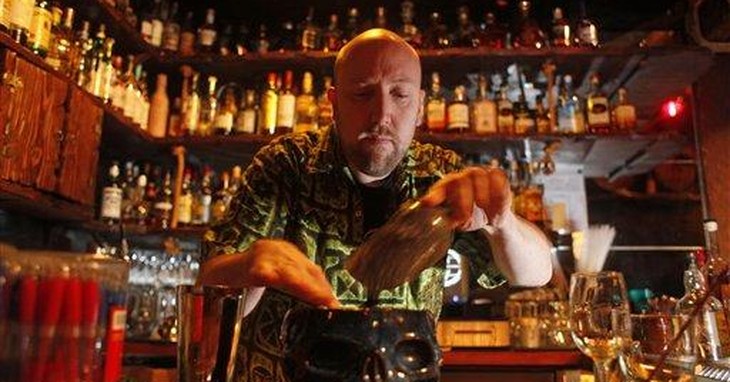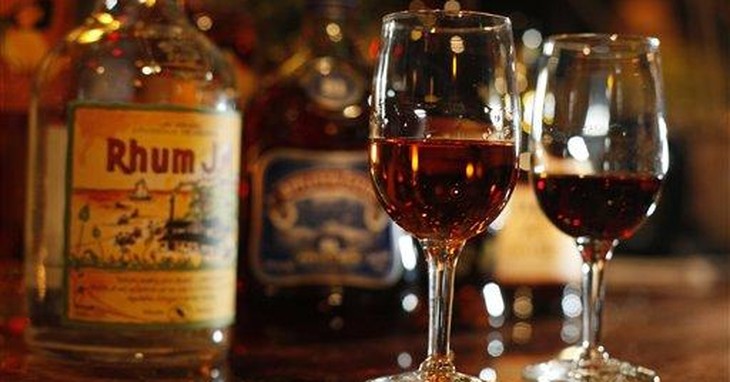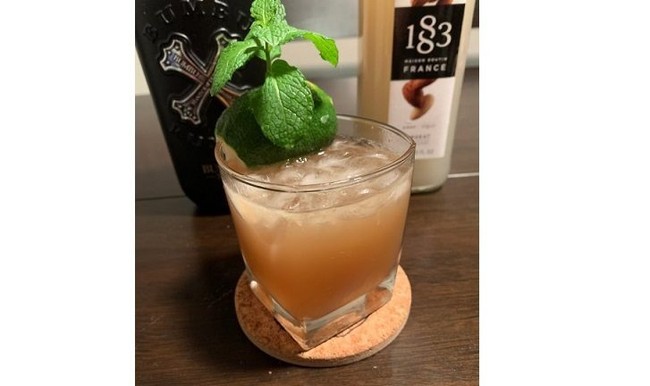It’s August 30, so you have one thing to do – Make yourself a Mai Tai, and make it correctly.
It is possible there could be some dispute around what is the preeminent, prototypical tiki cocktail. What better way is there to stage a barroom argument than around cocktails themselves, but one thing is probably unanimously agreed upon: If you construct a Mount Rushmore of tiki cocktails the Mai Tai is sure to be carved into the edifice.
When it comes to tracing the history of particular drinks it seems there can be two familiar paths that are found; either there is a defined starting point to establish credentials of a classic, or there is a nebulous origin that only builds the mystique. As it stands with the Mai Tai it is fittingly a case of both, and therein lies the fun. Add to the mix that it involves the two foremost names of tiki culture history seems only appropriate.
So we do have a specific date of creation, but the crafting of such is somewhat in dispute. In order to get all the factors involved appropriately let’s delve into some wartime history so we can get all the needed backstory in place. We begin in World War I.
The Boisterous Aviators
Coming out of the war it is not unexpected that servicemen would come together stateside. Along with VFWs and other organized groups, there was one loosely banded gaggle of pilots who formed a drinking club while serving in France. “The American Flying Club” was reconstituted stateside, and the gathering gained the notice of a journalist who detailed their raucous activity, dubbing them with the ironic title, “The Quiet Birdmen”.
As more aviators joined the group swelled and had to decamp from the restaurant where they regularly met, soon spreading to other portions of the country. (These regional clubs were then called hangers). Eventually, the Quiet Birdmen spread to California, and this is where our cocktail history begins to sprout.
In the 1930s the official birth of tiki culture took place in Southern California, as a man who was rechristened Donn Beach opened the famous Don The Beachcomber restaurant in Hollywood; this was the first tiki bar, as they are known. Years after opening Don’s was visited by a one Victor Bergeron Jr., who was not only captivated by the atmosphere therein, he became inspired. Owner of a nondescript family restaurant in the San Francisco area Bergeron was so enthralled he morphed his place into a tiki kingdom, and Trader Vic became a tiki godfather.
It is said that late one summer Vic concocted the first Mai Tai. The lore goes that upon its creation Vic had some visiting friends from Tahiti sample his new potable and they declared it outstanding, in their native tongue; “Mai Tai” is a slight alteration, supposedly coming to mean “The best”. While this is a fanciful tale it almost feels a little too pat to register as history, but frankly, this is but a toss-away concern. More important is the claim of this recipe being lifted – from Donn Beach.

Un-Tai-ing The Knot Of Origin
Vic Bergeron never made it a mystery that he had become inspired to create his signature restaurants after a visit to Don The Beachcomber. He freely admits having visited the location and then going back up north and over time transforming his existing local establishment into more of a Polynesian-themed location, eventually becoming the first Trader Vic’s. Now the mystery of our celebrated cocktail begins.
Bergeron’s new drink was said to have been first served in 1944. His visit to Don the Beachcomber was to have taken place some three years after it had opened, roughly 1937. This is where there is a grand source to rely upon for some of the particulars. Jeff Berry is the definitive historical source of tiki cocktails, and he did his share of sleuthing for his book, “Sippin’ Safari”. Berry, in looking into the provenance of the drink, noted that there is no Mai Tai listed on menus from the 1930s. Donn Beach also published a drink recipe book in that time period, and the drink is not offered there as well.
I found an archived menu from Don the Beachcomber, dated 1941, from the McFadden Place address, where Donn had moved across the street to expand his operation. This is four years since Vic Bergeron’s visit, and still, no Mai Tai is listed among the dozens of original offerings.
But, vital for this day — although credited with something in the realm of 60 originally-created cocktails, there is not a listing for a Mai Tai. pic.twitter.com/JQRrebAaXn
— Brad Slager: Semi-Fascist Practicing to Turn Pro (@MartiniShark) August 30, 2022
The claims of a Donn Beach creating the drink seem to emanate less from Mr. Beach himself than from his wives. When Beach returned from a stint of military service, from 1942-45, his ex-wife – who was put in charge of the chain – had expanded the Beachcomber empire greatly, and Donn found himself basically edged out of his own creation. He signed over control and was held on as only a name and face for the brand.
The first challenge to the origin of the Mai Tai was in the 1970s, as a Don the Beachcomber powdered drink mix was coming into the market. Late in his life, Donn’s third wife Phoebe also made the claim of him inventing the drink, but a recipe cited is a departure from Vic’s, including items such as Pernod, Falernum, bitters, and fruit juice. But while there appears no direct proof of an originating Beachcomber Mai Tai, there is another original from which it may well have sprung – which brings us back to the WWI aces.
Donn Beach was always giving a nod to America’s servicemen (his famed cocktails Three Dots & A Dash, and the Test Pilot serve as evidence), and in this manner, he had gotten wind of the airmen’s club, so he created for his drink menu the Q.B. Cooler. This complex potable has some elements seen in the Mai Tai; two rums, lime juice, a sweetener (honey, as opposed to simple syrup), and the tipoff being the Caribbean component Falernum.
This last detail is telling, as the original Mai Tai recipe is notable for its use of Orgeat. This almond-based mixer bears a similar taste profile to Falernum, so it is speculated as to whether Vic had tried to reverse-engineer the Q.B. Cooler back in his home base restaurant. If so, he managed to create something that is altogether a drink unto itself – and one that rather quickly became compromised.

The Mixologist Compromised Himself
While Bergeron saw his creation grow in popularity it did not take long for a series of events to lead to the drink evolving rapidly from its foundation. One of the culprits was Trader Vic himself. As he was expanding his empire through partnering with hotel corporations, one of the ventures involved Bergeron being brought in by Matson Cruise Lines to develop drink menus at its resort hotels in Hawaii. The Mai Tai morphed there, becoming an elixir of fruit juices and other new ingredients, as well as sporting garnishes of a dramatic nature.
Next came Elvis. His film “Blue Hawaii” in 1961 featured the drink prominently, and its popularity swept through the tiki bars that proliferated across the country. By the 1970s it took on more prominence as a favored presidential potable of Richard Nixon, who frequented the Trader Vic’s nearby the White House. By this time the drink no longer even resembled its former self, growing in its length of ingredients as it grew in popularity, becoming a fruity, syrupy shadow of its former self.
Contemporary tiki mixers – Jeff Berry in particular – have steered the outrigger back into the proper waters these days. Vic’s original mixture cannot be exactly duplicated today, due to the scarcity of some of his prescribed rums. Bergeron used 17-year-old Wray & Nephew at the time as one of his base rums. The drink’s popularity depleted stocks and today – well, a bottle will fetch you tens of thousands of dollars. This means adaptability and taste are the keys.

I like to go with Bumbu XO as my aged selection, and either Caruba Dark rum or a Martinique Rhum Clement Agricole is a solid selection. What you will end up with is not a flashy and garish brightly-colored attention seeker but a stately amber-hued classic. Cut a lime in half for your juice and save the shell. Then tinker, just slightly for personal taste. But for the most part here is the closest you can get to sitting inside a post-war Trader Vic’s
The Mai Tai
In a tall shaker fill it halfway with cracked, not crushed ice. Take the empty lime rind and pierce a hole in the center in order to insert a sprig of mint, to replicate a palm tree on an island.
- 1 oz. Aged Rum
- 1oz. Agricole Rhum or Caruba Dark Rum
- ½ oz. Orange Curacao
- 1/2oz. Orgeat
- 1/4oz. Simple Syrup
Shake ingredients at least 30 seconds to well chilled, pour into a double Old Fashioned glass. Garnish with the lime shell and mint.
Settle back, savor the rare blend of exotic flavors, and know that you are doing your part to restore this classic to its position of tiki glory.














